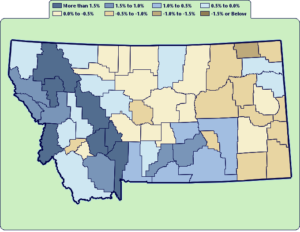By Ann Schwend
Average annual percent change in population by county from 1970 to 2021.

Source: Montana REAP.
In 1972, Montana’s newly adopted Constitution was followed by the Montana Subdivision and Platting Act (MSPA) in 1973. That same year, a young environmental organization (EIC at the time) was worried about the impacts of subdivision sprawl.
This concern inspired a dedicated team of staffers and volunteers to embark on the Montana Subdivision Inventory Project “to unearth the extent, pace, costs and ramifications of land development in Montana.” This project established a foundation at MEIC of closely monitoring the intersection between land use and environmental impacts that persists even 50 years later:
“Montana’s history is deeply rooted in the land. The extraction of the land’s wealth and the miseries that it brought to Montana should warn us that land cannot be abused without consequence and that growth cannot proceed unbridled…If we value our rural nature and our open spaces, then we must forget the tired old belief that all growth is good. And we must recognize that Montana’s resources – agricultural lands, wildlife and forests in particular – are finite.” -Montana Subdivision Inventory Project
Without internet access, the team meticulously combed through county files to manually review certificates of survey to assess the amount of land that had been subdivided in 35 of Montana’s fastest-growing counties. The team found that 334,017.9 acres had been divided into 114,085 lots since early statehood, but because of inconsistencies, they estimated closer to half a million acres had already been subdivided. This incredible inventory was published in 1975, along with many stories outlining the perils of subdivision sprawl on agriculture, wildlife and communities. You can read it on our website: www.MEIC.org/montana-land-development/
The team also found that development was accelerating and predicted that the boom in the Bitterroot “could chop up the valley’s whole land base by 1979” into parcels of less than 40 acres.
When the project began, subdivision review requirements were limited to only parcels under 10 acres. In 1974, after significant efforts from EIC, the acreage increased to any parcel splits less than 20 acres. This change generated a surge in activity by developers to quickly get their properties platted before the new rules were in place.
This doesn’t sound so different from the attitudes of developers today, but much has changed since the original subdivision inventory was published. It’s no secret that Montana has grown significantly over the past 50 years, especially in the past few years.
The Helena Independent Record reported in 2022 that Montana’s overall population expanded by 1.5% from July 2021 to July 2022, making it the sixth fastest-growing state in the nation by percent change. According to the Montana Regional Economic Analysis Project, some counties in Montana have experienced more than +1.5% average annual percent change in growth every year since 1970.
The demand for new development is skyrocketing. The Montana Department of Labor reported a 78% increase in permitting of new housing units from 2019 to 2021. Average home prices in Montana also increased by 50% between 2020 and 2022.
MEIC is closely monitoring sprawl and untethered growth in our rural areas, because high demand can lead to expedited processes and unintended environmental impacts. Sustainable development should not occur without a comprehensive review of the potential impacts to water resources, landscapes, wildlife habitat and how these sprawling growth patterns contribute to climate change.
At the very least, it’s time for an update to MEIC’s seminal 1975 Subdivision Inventory to help us better understand growth pressures in Montana, and policy mechanisms for addressing unnecessary sprawl. We are in the information gathering stage to compare where we have been, where we are now, and where we need to go. Get in touch if you have resources, expertise or ideas you’d like to share.
This article was published in the September 2023 issue of Down To Earth.

